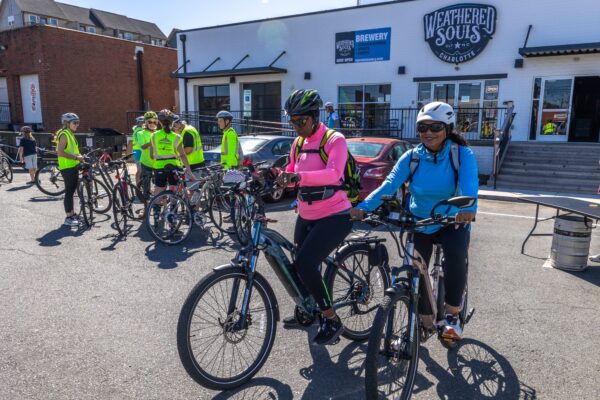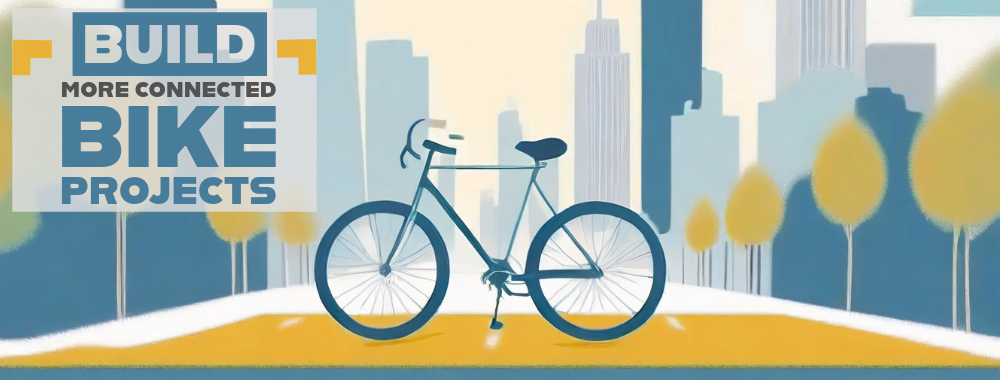In spring 2024, we asked residents to join us in telling city council members that our bike network is an important community resource that deserves more funding!
In June 2024, Charlotte City Council restored $65 million to the capital budget for the next two years to fund sidewalk improvements, strategic investment areas, Corridors of Opportunity, and transportation improvements in center city. Through an action alert, we mobilized residents to contact their Council members prior to the vote with a simple message: This funding is critical for safe and equitable mobility.
During the meeting, Council Member Malcolm Graham acknowledged that hearing from constituents was what helped them shift their thinking.
“I just really want to thank the public, because you contributed as well. You saved cuts that were being proposed. . . For your advocacy, your emails, your phone calls, you gave some members courage to put it back in the budget so that we can fully fund these areas throughout the city of Charlotte. We can’t increase taxes and then give you nothing back in return.”
While we didn't get the increased funding for Charlotte’s bicycle program that we'd asked for, the restored funding for sidewalks, Corridors of Opportunity and transportation improvements as well as $8 million for bikes and $20 million for Vision Zero is a record level of investment in making our streets safer for walking, biking, scooting and rolling! The restored capital funding includes bike and pedestrian improvements in Charlotte’s Strategic Investment Areas (SIAs).
We have a long way to go, but this is a vital step forward in making Charlotte a place where people of all ages and abilities can safely navigate without relying on cars.
Read on to learn more about why an increase in the bike program budget is essential -- and how we’re advocating for it!
Take a look at the Priority Bike Network
Below, the map on left shows the existing, disconnected bike facilities while the map on right shows the connected Bike Priority Network that additional funding would allow us to complete faster.
Map of existing bike lanes

LEGEND: Blue indicates completed bike lanes. This map does not show greenway segments that are also part of the Bicycle Priority Network.
Map of Priority Bike Network

LEGEND: light green is proposed greenway, dark green is existing greenway, light blue is proposed bike lane, and dark blue is existing bike lane.
Why we asked and continue to advocate for an increase in bicycle program funding

Build at least 10 miles every year
The current funding allows, at best, four to five miles per year of All Ages and Abilities (AAA) bike network facilities.
Although some progress has been made toward building out the 173 miles of the Bicycle Priority Network, given the current funding, there will be gaps totaling more than 100 miles by 2040[1]. By increasing the budget allocated for the bicycle program, we can double the miles of bike lanes built per year and meet the goal of completing the priority network before 2040.
Make progress in shifting mode share
In order to achieve the goal of reducing the current 76.6% single occupancy vehicle mode share to 50% by 2040[2], we need to make tangible progress in investing in walking, micro-mobility, and public transit. This requires a change in the allocation of funds, as alternative modes have been underfunded or nonexistent for many decades.
The Strategic Mobility Plan confirms that 65% of participants who were surveyed during public outreach want more options and opportunities to use modes of transportation other than cars. However, past investments have not resulted in a well-connected network, which makes the limited infrastructure for cyclists vulnerable to adverse weather conditions, construction, and street closures. We need alternate modes of transportation to help mitigate congestion and promote healthy, active mobility. There simply aren't enough miles of safe infrastructure for all ages and abilities to provide a convenient route to where people need and want to go.
Safety, safety, safety!
Despite only being involved in 3% of crashes from 2017-2021, pedestrians and cyclists accounted for 40% of traffic deaths[3]. However, cities that have invested in building protected bicycle facilities have witnessed a decrease in traffic fatalities for all road users while experiencing a significant increase of 51% in the number of people traveling by bike[4].
The City of Charlotte has acknowledged the need for safety in its transportation system by adopting the Vision Zero goal in 2018. Despite this aspiration, Charlotte has seen an increase in traffic-related deaths and an uptick in fatalities for non-motorists. As research has shown, increasing the budget allocation will help the city work towards reversing this trend for both motorists and non-motorists alike.
Costs and local economics
Bicycle facilities have been proven to boost local economic activity[5] while being less expensive to build and maintain, having a longer lifespan, and accommodating more people per unit of space than traditional roads. Given that 44% of major roads in Charlotte are in disrepair[6], it's worth considering cost-effective alternatives like more bike infrastructure instead of building more roads.
Supporting the environment
In order for the city to achieve its 2050 Strategic Energy Action Plan (SEAP) goal of drastically reducing per capita greenhouse gas emissions, we must increase climate-friendly transportation.
Together we can show decision makers that residents need and support a fully funded bicycle network
More Reading
Take a look at the Uptown CycleLink Study for their proposal on building a bike network in Charlotte.
Explore Charlotte's bicycle infrastructure: Join us for Biketoberfest!
Biketoberfest is your unique opportunity to explore our city on an epic, family-friendly scavenger hunt as you walk, run, or bike along a designated route and collect goodies and raffle tickets along the way!
References
1: Page 105 of Strategic Mobility Plan
2: Page 27 of Strategic Mobility Plan
3: Page 6 of Strategic Mobility Plan
4: https://www.sciencedaily.com/releases/2019/05/190529113036.htm
5: https://www.sciencedaily.com/releases/2020/04/200422151318.htm
6: https://tripnet.org/wp-content/uploads/2023/04/NC_Charlotte_WJZY_FOX_04-19-2023.pdf

